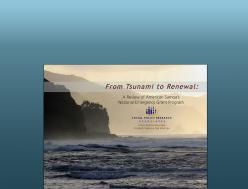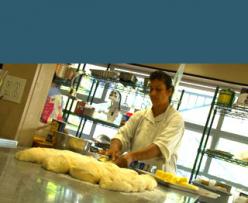The Report
The Report, Executive Summary & Project Profiles
The American Samoa National Emergency Grant Program Review - From Tsunami to Renewal - resulted in a suite of products that include:
- A collection of videos including: a 35-minute documentary; a collection of video interviews with agency and community leaders, program managers, and members of the community; and a "Behind the Scenes" video documenting our methods and approach.
- A website and library archive that contains links to all of the resources used in the making of the report and summarizes the major project components, methods, lessons, and findings.
- The report - the results of our program review together with a description of methods, lessons, and a summary of findings. The full report includes an Executive Summary and project profiles. This report, as well as separate Executive Summary and project profile documents, can be dowloaded using the document icons on the right.
Findings
The SPR team spent nearly a month immersed in the NEG program in American Samoa and conducted a brief visit to Guam. With the help of our on-island project team, we spoke formally with over 100 individuals and informally with dozens more.
What we found is a workforce development strategy which blended capacity building, bold program investments, and direct business engagement to connect people with training, education, and jobs leading to careers. The NEG program:
- Brought new testing and training opportunities to American Samoa’s only college;
- Created a diverse range of work opportunities for hundreds of participants, exposing many to new jobs and work environments;
- Established a first-of-its kind culinary training program that helped NEG participants begin new careers and launch new businesses;
- Collaborated with Pacific region neighbors, tapping into training and job opportunities in high-growth Guam; and,
- Launched a major job creation effort and opened the territory’s first One-Stop Career Center.
Although not strictly part of the strategy, the NEG also did something as important as any of its individual programs or initiatives: it revealed the critical importance of investing in workforce development as a foundation of the territory’s future prosperity.
The genesis of the NEG program was a terrible disaster that caused tremendous devastation in the territory.
But if there is a silver lining, it is in the opportunity for American Samoa's leaders, workers, students, and families to begin to think differently how workforce development - cultivating people and their skills and talents - can play a role in improving the economy and wellbeing of the territory.
Recommendations
The NEG program enabled workforce leaders to employ workforce development in a new way, cultivating the economic assets they hope will anchor American Samoa’s long-term recovery, creating new jobs and bringing new development opportunities to the territory.
We encourage the American Samoa’s leaders to:
1. Embrace the broader workforce agenda that has evolved since the launch of the National Emergency Grant. Five primary components of this broader agenda form the heart of our recommendations
- Deepening and strengthening formal and informal relationships with territorial and federal agencies on- and off-island. Working with US and Guam Departments of Labor colleagues to secure the National Emergency Grant, and the Department of Interior on capacity building are examples of reaching beyond traditional approaches to workforce development. These efforts may be even more crucial in the post-grant period, especially as the Comprehensive Economic Development Study (CEDS) nears completion and the new administration of Governor Lolo Moliga begins to shape post-tsunami development.
- Collaborating with government and private-sector partners throughout the Pacific region. In keeping with the American Samoa Government’s longtime strategy to strengthen linkages between islands across the Pacific region, the NEG team worked closely with their colleagues in Guam to plan, launch and managed the NEG program, even collaborating on a first-of-its-kind construction training program for American Samoans willing to learn and work in Guam. New opportunities are likely with continued commitment to regional collaboration.
- Advancing innovation and enterprise, while effectively managing risk. As American Samoa moves away from a development approach dependent on low wages to one that prioritizes higher skills and creative enterprises, it must experiment with new approaches – supporting self-employment, prioritizing emerging sectors and clusters, and advancing workplace-based development initiatives. The NEG program provided opportunities to pilot new ideas, like the culinary training program. The Work Experience Internship and OJT programs engaged dozens of private sector employers, many of them small. Finding ways to attract resources, scale effective initiatives, and vet and test new ideas while balancing potential risk are critical capacities needed across sectors among American Samoa’s workforce leaders.
- Developing strategic relationships with philanthropic and non-profit organizations on- and off-island. American Samoa’s “social good” sector (philanthropy, charitable giving, and non-profit organizations) is young, undercapitalized, and lacks access to peer networks, regular technical assistance, and local capacity building champions.[1] Many manage only project-based funding, ceasing operations between projects, which impedes their ability to grow or develop deep expertise in critical areas of need in American Samoa.[2] The territory’s public and private sectors could play a role in building the social sector’s capacity by engaging those non-profits with complementary missions[3] as long-term workforce development partners.
- Shifting away from “program” as the heart of workforce development and toward the idea that workforce development is about effective people management and development practices that can be adopted in any school or workplace. The old model of workforce development was about training people for available jobs. Increasingly workforce professionals also play important roles in advocating for career education in schools and professional development in the workplace; collaborating with industry to access training and development; promoting self-employment; helping organizations – public and private – to adopt modern talent development and management practices. These activities create value for firms and help individuals and families whether they are participants in workforce programs or not. NEG staff took initial steps toward this broader role in phase II of the program. To further advance this agenda, a network of the Chamber of Commerce, the Workforce Development Commission, the Territorial Planning Commission, and others – have an opportunity to adopt exemplary workforce practices that can increase productivity, grow jobs, and seed new industries.
2. Engage the extended family (‘aiga’) network.
- We saw countless examples of American Samoans returning from the US mainland or elsewhere to assist their families after the tsunami, leading game-changing initiatives by engaging their off-island networks. Chef Sualua Tupolo, who launched the American Samoa Culinary Academy, is one example. At the same time, there are thousands of networks in the US comprised of American Samoans who are working or attending school. Families, churches, and now workforce programs are engaging these networks in ways that help students and new arrivals succeed. American Samoa’s leaders must build and support networks that enable opportunities for off-island education, training, development for residents of American Samoa, and opportunities for US mainlanders and Pacific islanders to learn and work in American Samoa. Reaching out to those who have returned home from military service, education, or off-island holds tremendous promise as a low-cost, high-impact workforce development strategy.
3. Employ technology strategically to advance the broader workforce agenda, and increase the training and job opportunities for American Samoans of all ages. Four specific opportunities are described below.
- American Samoa Community College is a large and well-regarded educational institution – even housing a Small Business Development Center on its campus. The government has supported the college in its effort to secure accreditation for its first bachelors degree program expected in Spring 2013. But the college cannot be expected to meet all of the education, training, and professional development needs of the territory. As Internet connectivity in American Samoa improves, online education and training programs, partnerships with off-island colleges and universities, and even peer-learning platforms can help fill that gap.
- Similarly, new service industry companies that employ individuals all over the world offer nontraditional employment opportunities, especially for women and people who seek part-time work or flexible hours. Some of these companies are even social enterprises, which would offer needed services as well as mission alignment.[4] Such strategies are new to workforce professionals – on the US mainland or in American Samoa – but are increasingly important tools for cultivating talent and enterprise in isolated communities.
- One challenge facing American Samoa is a lack of timely and high-quality workforce data. There is no Department of Labor on the island, and therefore no system for regularly tracking employment, wages, and other important labor market information. However, as the cost of technology decreases and access improves, workforce professionals across sectors could find ways to employ these technologies, even in collaboration with one another, so that territorial leaders would have access to good information about jobs, skills, and the movement of people through the labor market.
- Finally, public agencies, non-profit organizations and others are just beginning to use social media to organize champions, supporters, volunteers, and even donors – and could engage small business lenders.[5] The National Park of American Samoa, is an example of a public agency that uses Facebook particularly well to engage its “tribe.” It will be increasingly important for public agencies of all kinds to engage this way as more citizens and residents demand it.[6]
Going forward, government, private sector, and community leaders must make serious choices about the focus of their economic and workforce development efforts. But they will be making these choices in the context of a community that has begun to understand the importance of workforce skills in the recovery of the island and in its accompanying economic, social and spiritual renewal.
[1] Using Guidestar, we identified 81 non-profit organizations registered in the territory, including one foundation. But 34 of these had lost their exempt status, many others are Church-affiliated, and very few have websites which would help people learn more about them.
[2] Two organizations heard about our project and contacted us, as technical assistance providers, to inquire about helping them with fundraising.
[3] The Pacific Islands Center for Educational Development (PiCED) supports educational achievement among the island’s young people and was the territory’s 2011 non-profit of the year. Intersections Inc. runs Nuanua Media Communications – a combined leadership development and film and media skills development program for young people. These are two examples of such non-profits but there are likely many others.
[4] Samasource, for example, is a non-profit organization that connects poor women and young people to training and employment in the digital economy and provides “microwork” for people in need all over the world.
[5] Kiva provides a platform that allows individuals to make small business loans to aspiring entrepreneurs who lack access to capital.
[6] We heard many anecdotes about young peoples’ expectations about education and jobs shifting as a result of communicating with off-island friends on Facebook – and we experienced this dynamic ourselves as American Samoan colleagues and friends began communicating with us this way.



